| Today was a beautiful, autumn day, a perfect Samhain: misty, grey and cold. The leaves were brown and blackberries ripe on the bush. Rebreatherstock at Stoney Cove, a meet of UK homebuilders arranged through the Yorkshire Divers web forum, would be in full swing. But the thought of getting up at 7am, driving a toll road or face Sunday muppet drivers, pay another tenner just to get hassled, jostled, told off and ripped off with a thousand other divers clammering to get in the water did not appeal. A late start and an easy drive through beautiful scenery rather than urban Midland sprawl and I was at Dorothea, quiet, dark and even after so many years, mysterious. | 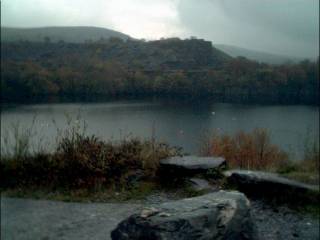 |
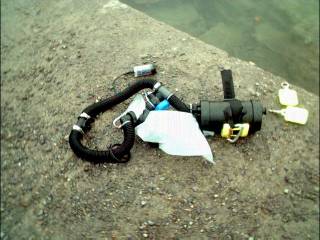 |
I have a new
scrubber on the way made by STDE in Switzerland. So I decided to re-use
the parts of the old rebreather in a new beastie. Inspired by Dr
Duncan Price's D5 rebreather I made up the first version of a sidemount
rebreather.
The rebreather is contained within a tubular cordura bag, scrubber at the bottom, counterlung in the middle and hoses coming out of the top. I cannibalised a Poseidon Cyklone 2nd stage into an ADV. Oxygen currently is added manually and monitoring is by two Teledyne R17D cells with a dual display monitor in a handset. The bottom scrubber end clips to a d-ring on the waist of the harness, the top clips to the shoulder d-ring: just like a stage bottle. I dived the unit with a pair of 12's backmounted and a 7l stage bottle of oxygen to drive the rebreather. Diluent was taken from the twinset. |
| The counterlung
is a single 10 litre water bag made by Gelert. These are cheaper than the
Flexiflask and Platypus bags I had been using but are much better quality,
tougher with welded seams and made of the same material and standard as
a wing bladder. The bag has a tap on the front which is easily removed
and replaced with a Draeger p-port and I added a second p-port at the other
end. One connects to the exhale port on the scrubber, the other to the
exhale hose from the DSV. On the other side is an AP drysuit inflation
valve for oxygen addition.
Because of its size I thought it might be a good idea to restrict the volume with some snoopy loops but breathing resistance was too high. When the loops were removed breathing resistance was much better, in fact better than the backmounted lungs I had used before. One of the major advantages of this system has been that I can swim completely horizontal without any difference in work of breathing. With the backmounted lungs I had to swim in a slightly head up position. |
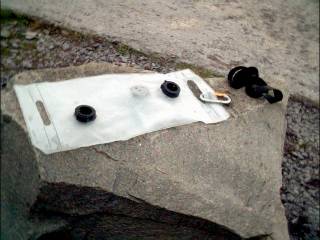 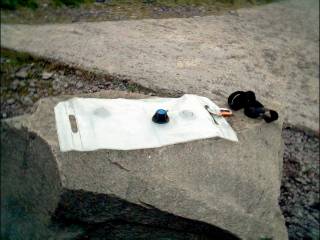 |
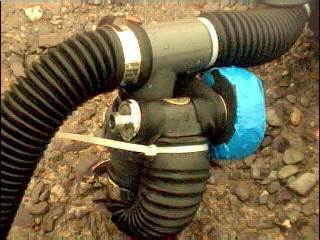 |
This is a close-up
of the DSV. In theory, a good idea, in practice, I have had better. The
design is simple, a 2nd stage is simply attached via some flexible hose
to a tee in the loop on the inhale side. When loop volume drops the regulator
opens and adds diluent until it equalises. The exhalation port is sealed
to stop gas loss (duct tape).
The big problem was the regulator was too sensitive, it fired on just about every breath. I did the first half of the dive in oxygen rebreather mode and then turned the ADV on, a hairy moment as it instantly started to fire and I watched the ppO2 dropping like a rock on the handset. It either needs a bit of modification (which I don't really feel like doing) or replace it with a Draeger Ray dosage head with the orifice epoxied closed to act as an ADV. Or add diluent manually. I like the idea of being able to flush the loop with diluent simply by exhaling through the nose but then it makes doing O2 flushes difficult unless I add a shut-off to the ADV. |
| One of the
things that really worked well on the dive was the dual display handset.
It has two backlit displays which read the Teledyne R17D cells in the scrubber
head. The handset is simply a clear lexan tube with a delrin plug with
barrel o-rings. The cable from the cells enters via a Sealcon gland.
The display worked spot on. I rigged the rebreather before leaving home and calibrated the displays to 0.21bar. I switched it on and it read 0.17bar but it settled to 0.21bar when I uncapped the scrubber inlet and read 0.98 when I flushed it with oxygen. Underwater it worked perfectly too, reading 1.19bar at 2m and 1.30bar at 3m. |
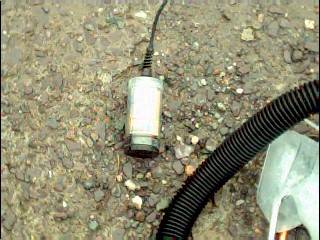 |
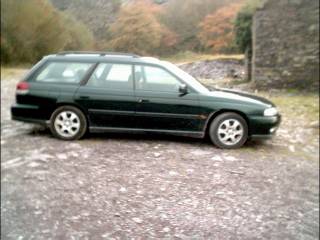 |
And finally
the last bit of kit I was testing today, my new 2.5l Subaru
Legacy 4-Cam. Very fast and smooth, I'd forgotten just how good Subarus
are to drive.
Tribute must be paid to my old dive-mobile, my Jeep Cherokee. By far the best dive-mobile I've had, but at close to 100,000 miles I'd had a bad report at the last service. The driveshaft needed replacing, the front discs needed replacing and it needed new tyres all round. I was concerned about the steering too as it was becoming a bit vague at high speeds and I was starting to get electrical problems which I thought was related to the LPG gas system that was added (the LPG heat exchanger burned out the wiring to the alternator) and the CD player went on fire (whilst listening to Velvet Revolver -- can I sue?). I was gutted to see it go but living in the city rather than the backwoods I couldn't really justify keeping it. Well done, old friend!!! |